Solar cells, polaritons and photodiodes
Aiming for new efficient photovoltaic energy conversion and detection of light we develop and investigate organic and metal halide perovskite semiconductors. We unravel operational mechanisms, develop new materials, investigate optical properties (e.g. polaritons and excitons), charge generation, recombination, morphology and thin film formation, and design, fabricate, and test advanced solar cell and photodiode configurations.
Perovskite solar cells
Metal halide perovskites attract considerable attention for application in photovoltaic cells. These materials have an ABX3 crystal structure where A is a monovalent cation, B is metal dication, and X a halide anion. The first perovskites used for solar cells consisted of methylammonium, lead, and iodide (CH3NH3PbI3) but in the meantime many more complex metal halide perovskites have been developed in which other organic or inorganic cations, different metals, and multiple halides are used. These perovskites can be processed from solution into thin films in one- or two-step procedures and afford very efficient solar cells. The highest reported efficiencies already exceed 26%. However, the materials pose several scientific and technological questions, regarding their operational mechanism, stability, and opportunities to further increase the efficiency.
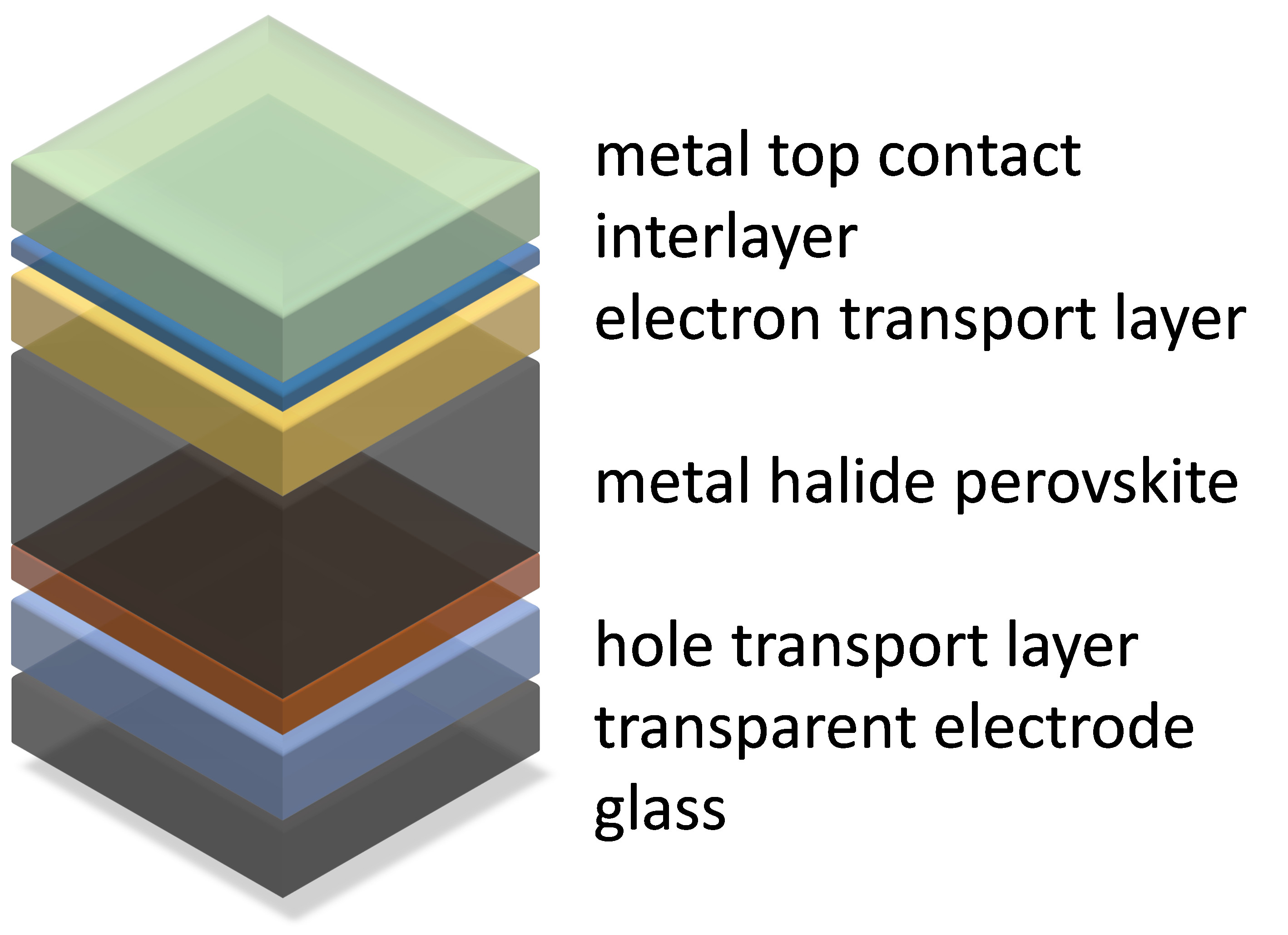 Layout of a thin film metal halide perovskite solar cell
Layout of a thin film metal halide perovskite solar cell
With the M2N group we investigate perovskite solar cells from different perspectives:
Band gap tuning
The CH3NH3PbI3 perovskite has a band gap of about 1.55 eV. Tuning of the band gap can be accomplished in several ways and can be very beneficiary. For example for the development of tandem solar cells two different band gap materials are needed and this can be accomplished by tuning the perovskite structure. Also indoor photovoltaic applications will require tailored absorber layers. By partially replacing lead by tin one can achieve band gaps as low as 1.21 eV, while by replacing iodide by bromide, the band gap can be increased to 2.32 eV. Another way of tuning the perovskite is by changing the dimensionality of the crystal. These are known as 2D Ruddlesden-Popper perovskites in which one or more perovskites layers are isolated from each other by the large spacer cations. Each new perovskite poses new challenges with respect to processing into thin and smooth layers, stability, and charge transport layers that allow extraction of electrons and holes without energy loses.
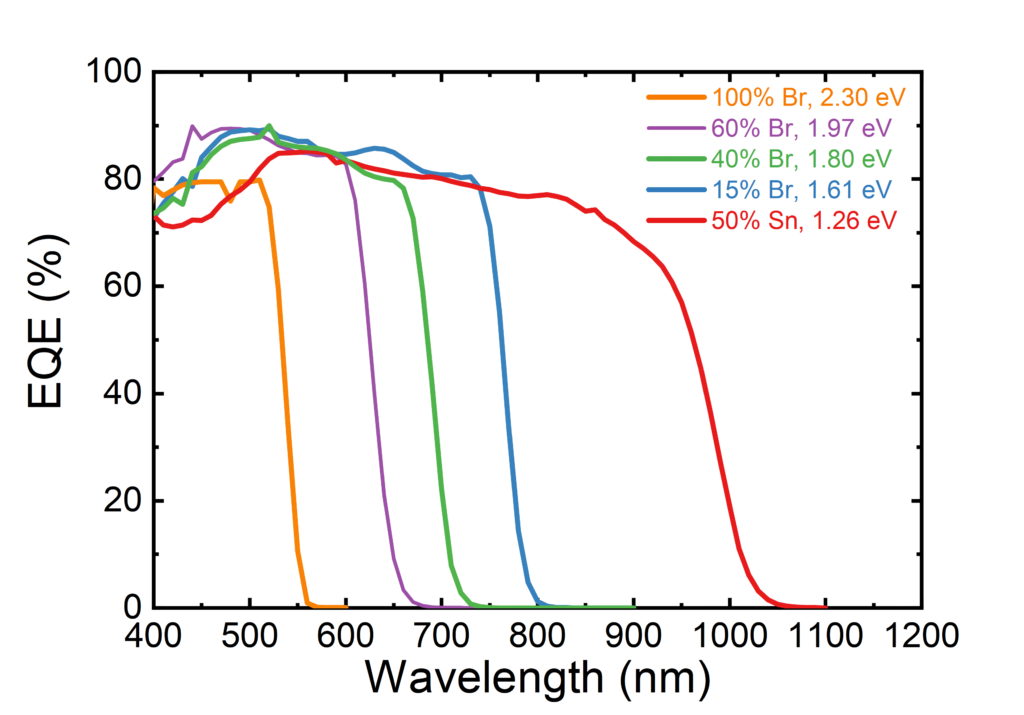 External quantum efficiency of metal halide perovskite solar cells with different band gaps
External quantum efficiency of metal halide perovskite solar cells with different band gaps
We develop new perovskite semiconductors, investigate these with a range of techniques such as X-ray diffraction, scanning electron microscopy, photoelectron spectroscopy, and fabricate and characterize solar cells based on these materials.
Multi-junction solar cells
To eventually surpass the 33.7% Shockley-Queisser limit for single solar cells junctions a well-knows strategy is to stack multiple cells with different band gaps. Obviously this requires absorber layers with different band gaps. We investigate both perovskite-perovskite, perovskite-silicon, and perovskite-CIGS tandem cells in two-terminal or four-terminal device configurations. To maximize light absorption and power conversion efficiency, we perform optical simulations on to design stack in order to reduce parasitic absorption and reflection losses. Especially for a two-terminal configuration a challenge is achieve current matching but also to fabricate the cells. Sometimes ten or even more layers must be stacked on top of each other. In case of solution processing this requires careful optimization and design of materials a processing steps.
Among the first groups in te world we have been able to report efficient triple-junction perovskite solar cells (Nat. Commun. 2020) and together with TNO we have set a new world record for four-terminal perovskite – crystalline silicon (c-Si) tandem solar cells with an efficiency of 30.1%. In monolithic tandems cells we have made 23.1% all-perovskite tandems (Adv. Mater. 2022) and 25.1% perovskite/c-Si tandem cells together with TU Delft.
Detection of defect states
Next to enhancing performance by improving materials and designing new device architectures, we study fundamental properties of these materials. Perovskites are known to have defects that may come as interstitials, vacancies, impurity atoms, lattice defects, phase separation, grain boundaries and others. On top of this, these defects are known to be dynamic: they can be mobile or change with time or operating conditions. One of the failure mechanisms is related to light-induced halide segregation in mixed halide perovskites which is studied both experimentally and theoretically (Nat. Commun. 2021). Some defects are important to the operation of the solar cells because they cause non-radiative recombination of electrons and holes that were generated by light. This non-radiative recombination causes a loss in the open-circuit voltage and to mitigate these effects it is necessary to understand in detail their nature. For this we employ different techniques such as electroluminescence, impedance spectroscopy, and photothermal deflection spectroscopy. We further developed an ultra-sensitive photocurrent spectrometer that is used in combination with optical modelling to unravel the location and nature of defects (Nat. Commun., 2022). We have also implemented home-built set ups to study quasi-Fermi level splitting optically. With these techniques we can unravel the factors that currently limit performance.
Contact
René Janssen
Martijn Wienk
Polaritons in organic semiconductors
Molecular semiconducting materials that strongly absorb visible and near infrared light are used in organic solar cells. For wavelengths near an allowed optical transition, crystals of dye molecules usually show high reflectance. This seems at first sight to preclude efficient absorption of light by the crystals. However upon closer inspection, the reflection band of these crystals near the allowed transition shows a minimum in reflectance in the middle of the band. This minimum can be assigned to polaritons. The polaritons arise from the strong coupling between electromagnetic waves with electronic polarization and excitation waves of the molecules. The polaritons allow for efficient in-coupling of light into organic crystals.
Within M2N we study fundamental properties of polaritons in organic crystals:
Upon illumination of the crystal at a wavelength corresponding to the excitation of polaritons at the minimum in the middle of the reflection band, light should be able to enter the crystal efficiently. Transport of the energy by the polariton to the interface with a second crystal can in charge carrier generation. The generation of carriers in turn should result in a photovoltage and/or a photocurrent. The external quantum efficiency spectrum of this photovoltaic action is to show a maximum at the wavelength associated with the minimal in reflection, providing direct evidence for the involvement of polaritons in the photovoltaic response.
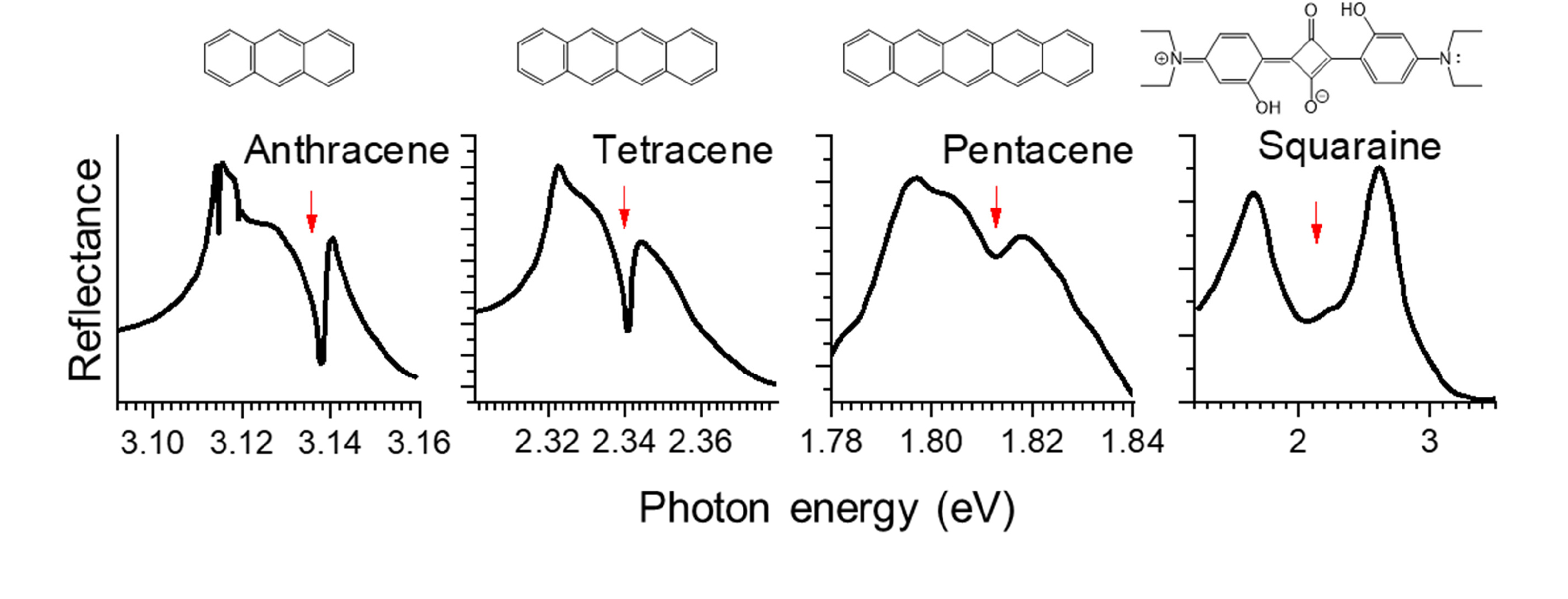 Reflection spectra for some crystals of organic dye molecules. The red arrow indicates the local minimum in the middle of the reflection band associated with the excitation of polaritons
Reflection spectra for some crystals of organic dye molecules. The red arrow indicates the local minimum in the middle of the reflection band associated with the excitation of polaritons
Contact
Stefan Meskers
Photodetectors
In collaboration with Holst Centre we study organic and perovskite photodiodes, that can be used in e.g. future artificial retina implants, photoplethysmography arrays, and fingerprint sensors employing perovskites (Nat. Electronics, 2022). We investigate dark current generation (Nat. Commun. 2021), to further enhance the specific detectivity of photodetectors (Adv. Mater 2022). Using an inherently-narrowband solution-processed, thin-film photodiode based on a tandem-like perovskite-organic architecture we achieve a narrowband quantum efficiency that can exceed 200% at 850 nm and that allows remote monitoring of heart and respiration rate at distances up to 130 cm.
Within M2N we investigate several aspects of organic photodiodes in close collaboration with Holst Centre:
Organic photodetectors
Organic semiconductors are very appealing for light detection applications. They combine effective light absorption in the green region of the spectrum with good photogeneration yield, sensitivity and response time. Since many organic materials can be dissolved in organic solvents, organic thin films can be easily formed using a solution or printing process without the need for vacuum equipment. This makes them specifically attractive for large area imagers. The low process temperature, typically less than 150 °C, creates the possibility to use a wide range of plastic substrates instead of glass. Solution processed organic photodiodes can show specific detectivity values exceeding 1013 Jones, combined with large linear dynamic range of and short response time of 0.1 ns.
The dark current of an organic photodetector and is a limiting factor to the detectivity. Electrodes with tailored electron-blocking and hole-blocking layers are then typically used to lower the dark current. Although dark current densities can be low, with values down to 10-7 mA cm-2, in favorable cases, the origin of the dark current in OPDs is, however, still a matter of debate. There can be several contributions such as current leakage via small pinholes in the photoactive film, but also dark current injection at either one or both electrodes, or even thermal generation in the absorber material. We are developing new materials and device configurations, in combination with detailed experiments to unravel the origin of the dark current and reduce it to the intrinsic limits.
Metal-halide perovskite photodiodes
Solution-processed thin-film metal-halide perovskite photodiodes are attracting attention for application in large-area light-sensing as they promise lower cost, spectral tunability, and high sensitivity. One of the key issues for reaching high specific detectivity in photodiodes is minimizing the dark current under reverse operating bias. We studied the origin of the dark current in perovskite photodiodes with sensitivity in the near infrared. Charge-blocking layers in these photodiodes are commonly used to minimize the injection of charge under reverse bias by creating an energy barrier. Via detailed analysis of the activation energies of the dark current we found that the actual activation energy is much lower than this barrier. Challenging the long-held view that charge-blocking layers only reduce dark current, we reveal that the dark current is in fact dominated by thermal charge generation at the interface between the charge-blocking layer and the perovskite semiconductor. Based on this new understanding of the origin of the dark current we modified the energy levels of the charge blocking-layers to minimize thermal interfacial charge generation and develop a near infrared perovskite photodiode with both a record-low dark current density of 5 × 10−8 mA cm−2 and specific detectivity of 2.5 × 1012 Jones in the near infrared.
Tandem-like perovskite-organic photodetecors
We rceently developed a novel optical sensor enables measuring a person’s heartbeat and respiration rate from a distance of over one meter using invisible light. The photodiode is based on a novel tandem-like perovskite-organic architecture which results in remarkable quantum efficiency of >200% for converting near-infrared (850 nm) light into photocurrent, under green bias illumination. The tandem-like device structure results in an inherently narrowband response which provides the device with a higher tolerance to the critical background light than optically-filtered based sensors. In combination with a low dark current (< 10−6 mA cm−2), a large linear dynamic range > 150 dB, and operational stability over time (> 8 h), the devices provide a spectral response of 1.5 A W−1 and noise-based specific detectivity of 3 × 1013 Jones. This exceptional performance allows detecting extremely weak signals resulting from low illumination sources, thus enabling lower power consumption. We demonstrated its potential in remote monitoring the heart rate and respiration rate from distances up to 130 cm in reflection.Tandem-like photodiodes represent a new generation of high-performance low-cost photodiodes that can be integrated in a variety of different applications, not only medical, but also in other areas such as wearable monitoring, light communication, surveillance systems, and machine vision.
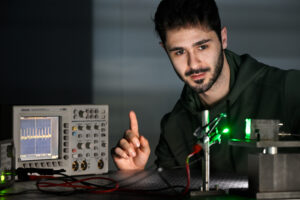 Tandem-like photodiode that can measure a heartrate from a finger at a distance from the reflected near infrared light (Photo: Bart van Overbeeke)
Tandem-like photodiode that can measure a heartrate from a finger at a distance from the reflected near infrared light (Photo: Bart van Overbeeke)
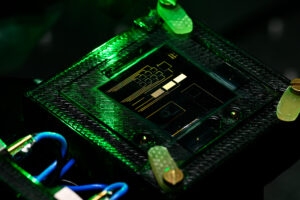 Tandem-like photodiode (Photo: Bart van Overbeeke)
Tandem-like photodiode (Photo: Bart van Overbeeke)
Contact
René Janssen
Stefan Meskers